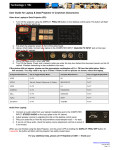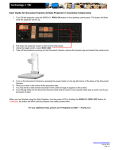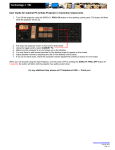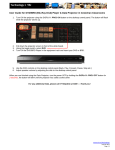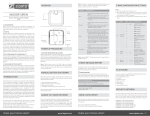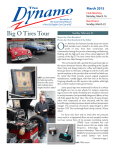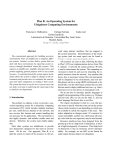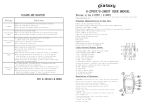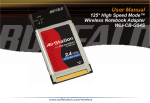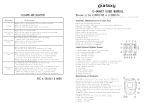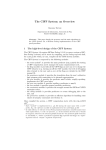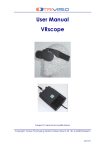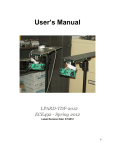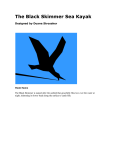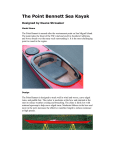Download Communications Plan - Swimmers Last Longer
Transcript
Swimmers Last Longer Communications Plan Mission: Help ensure the success of the swim Objectives: Facilitate handling of emergencies Pass current position of Swimmers back to Command Tent Pass information between Escort Boats and Paddlers Pass instructions to distributed teams Pass photos and PR messages back to command tent Scope: Communications between teams on water and on land Communications with recreational lake users Out of Scope: Communications with press and public Goal: Have a primary and a secondary means of communication to meet each of the Objectives. Participants: (see diagram and legend) Swimmers Paddlers Outriggers Escort Boats Shuttle Boat Mother Ship Volunteer Fire Dept Boat Command Tent Waiting Paddlers Gofer / Messenger Recreational Lake Users Dalton & Theresa's Home Emergency Medical Services (EMS) Swimmers Last Longer Communications Plan Page 2 of 12 Resources: The resources presently used in this plan are as follows. For a more detailed technical description of some of the resources, see Appendix A. Communication Means Marine VHF radios Purpose and Brief Description Handheld and mobile (boat-mounted) radios using frequencies around 160 MHz. Marine VHF will be used for boat-to-boat communications, e.g. between an Escort Boat and the Mother Ship. FRS/GMRS Radios Handheld radios using public unlicensed frequencies in the UHF band, around 462 and 467 MHz. SLL has 12 Motorola MS560CR handheld waterproof FRS/GMRS radios. They will be used for communications between the Paddlers, Outriggers and the Escort Boats. UHF Radio SLL will establish a commercial UHF radio net on a frequency around 462 MHz using a repeater, a base station and several handhelds. Locating the repeater on Bald Mountain should ensure coverage for the entire length of the lake. The UHF net will be used for long-range communications between the Command Tent and the support boats (Escorts, Ferry, and Mother Ship). Cell Phones Coverage is available only in the SE portion of the lake and in the immediate area of Heather campground in the NW end. Text messaging is more reliable than voice under spotty coverage conditions. Cell phones will be used for communications with external agencies (e.g. TV and radio media, Emergency Services). They can also be used as backup for the other means in some locations. Landline Phone One is available at the Lakeview campsite. The Landline phone will be a backup means of reaching Emergency Services. SPOT satellite position reporting system SPOT uses a small GPS receiver and satellite transmitter to send position reports via the Globalstar satellite system. One SPOT transmitter will be carried by each of the two Paddler/Observer boats, and will provide automated position reports Swimmers Last Longer Communications Plan Communication Means Page 3 of 12 Purpose and Brief Description for the Swimmers every few minutes. The Command Tent and supporters will be able to track the Swimmers online. WiFi WiFi may be available at the Command Tent. This will be the preferred way of posting progress updates and photos to the SLL web page. The alternative to WiFi access at the Command Tent will be Internet access at Dalton & Theresa's home, via a Gofer/Runner. Voice Voice is the primary communications method between the Swimmers and the Paddlers. If the Swimmers are unable to hear/respond to voice, then the backup methods are Whistle/Horn and Lights. Whistle / Horn Each Paddler team will have a Whistle or Horn as an alternative for getting the attention of the Swimmers. The Whistle / Horn may also be used for getting the attention of the Escort vessels or other boats. In accordance with the IMO (International Maritime Organization) Collision Regulations the following signals are recommended: • 5 short blasts – the intentions of the other vessel are in doubt and may be dangerous (for example a collision with another boat or a swimmer appears imminent) • 3 short + 3 long + 3 short (SOS); or one continuous blast. Used in case of emergency (e.g. person drowning) Lights on Boats At night, Lights on the boats will serve three purposes: • the powered vessels (Escort, Ferry, Mother Ship) will display Navigation lights (red, green and white sectors) to alert other boats • the Paddlers will display an all-round white Navigation light to alert other boats • the Paddlers will display underwater and/or waterlevel lights according to the preferences of the Swimmer. These will be used to orient the Swimmer and to communicate events such as stops for feeding. One suggested configuration is towing several glow-sticks underwater so the swimmer can judge distance and orientation. A glow-stick of another colour can be used to signal stops to the Swimmer. Lights on Swimmers Lights on the Swimmers will be used for tracking by the Paddlers. Swimmers Last Longer Communications Plan Communication Means Page 4 of 12 Purpose and Brief Description Glow-sticks will be attached to the swim cap or back of the swimmer. A blinking waterproof LED light will also be attached to the swimmer. Flags Flags will be used for two purposes: • the Escort vessels will display the code flag 'A' to indicate that there is a Swimmer in the water. Note that this signal officially means “Diver Down”, and there isn't an equivalent for “Swimmer In the Water”. • The Paddlers can use signal flags to pass messages to the Escort boats, as an alternative to the FRS/GMRS radios in case the Swimmer prefers to not hear routine communications. We could define flags for “Need more Food/Water” and any other messages we decide are needed. In addition to the code flag 'A', the Escort boats will also display the N. American 'Diver Down' flag, which may be more widely understood. Some potential resource that don't form part of the plan at this time are listed in Appendix B. Swimmers Last Longer Communications Plan Page 5 of 12 Participants' Communications Methods The Participants will be using the methods indicated here. An arrow represents a message between two participants, and each arrow is annotated with the communications method. If two participants are not linked with an arrow, they can relay their message via a third participant. Swimmers Last Longer Communications Plan Page 6 of 12 Frequencies Frequencies/channels to be used are: Means Channel/Frequency Purpose Marine VHF Channel 16 Distress and general hailing of recreational boats. Channel 68 Communications between the SLL powerboats (Escorts, Ferry, Mother Ship) Channel 69 Alternate channel if 68 is being used by other stations. TBD Communications with the Volunteer Fire Dept Boat FRS / GMRS Channel 19 Communications between the Paddler/Observers and the Escort boats. UHF ~462MHz, TBD Communications between Command Tent and SLL powerboats (Escorts, Ferry, Mother Ship) Phone List Following are the contact phone numbers: Location / Person Number Command Tent Comments 250-xxx-yyyy Command Tent (alternate) Ambulance Fire Police Ron Merchant 250-580-5044 Escort boat pilot Roger Escort boat pilot Dalton M Escort boat pilot Campground Office Lakeview campground Radio Station XXXX TV Station YYYY Alex's Emergency contact Swimmers Last Longer Communications Plan Location / Person Number Page 7 of 12 Comments Susan's Emergency contact Labelling The resources that can possibly be confused with each other (e.g. FRS/GMRS handhelds which look much like the UHF handhelds) will be labelled with their type or purpose. The handhelds will also be numbered so we can track where they are / who has them. Radio Recharging The Marine VHF radios in the power boats will be connected to the boat's electrical system and will not need recharging. The handheld radios (FRS/GMRS and UHF) will need periodic recharging. The general approach will be to recharge at the Command Tent. There are 12 FRS/GMRS radios: six will be in use at any one time (1 each to the Paddler/Observer, the Outrigger, and the Escort in the two teams). Two more will be used as spares (1 each in the Escort boat). The remaining four will be at the Command Tent, charging. I notice that the User Manual claims that charging takes ~14 hours; this is too long if the battery life is less than 14 hours. We may need to stock on each Escort boat some rechargeable AA batteries (each radio takes 3 x AA) that can be swapped in as needed, until charging is completed at the Command Tent. TBD. The commercial UHF handhelds can be recharged at the Command Tent, or on board the Escort boats if they have 12 VDC lighter sockets available. We will aim to rotate handhelds every 12-24 hours (TBD based on tested battery life) using the Ferry to deliver the radios. Radio Procedure Training in proper radio procedure will be provided. The aim will be to have clear communications and efficient use of the resources. The skills that will taught are: • emergency traffic takes priority over all other messages • be polite. No swearing. • when calling someone, refer to them by the position, not their name. For example, say “Escort 1, Escort 1. This is Observer 1.” This will minimize confusion due to shift changes – the same personnel will not always be working the same position. Once you have made contact, then it is fine to use the person's name in the conversation. For example “Hi Escort 1. Ron, can you send over some more bananas please.” • When transmitting, key the microphone and wait about a second before speaking. The FRS/GMRS radios in particular need a short time to recognize a tone sent by the transmitter indicating what net it is a part of. If you speak too soon, your first words will be cut off. Swimmers Last Longer Communications Plan • • • Page 8 of 12 When calling someone and there is no answer, wait a half minute or more before trying to call them again. They may have been busy with some other activity. After three tries you may want to call another station and see if they can raise the party you wanted to speak with. In case of an emergency, the key word that alerts everyone that an emergency is taking place is “Mayday” Repeat this word three times at the beginning of your transmission to get everyone's attention. Follow that with a calm description of the situation. Unless your Swimmer has told you otherwise, keep your radio conversations to a minimum when within earshot to reduce distractions. If asked by the Swimmer to keep quiet, use one of your alternate communications means. Schedule It is suggested that checkins on the various radio nets happen at least every hour. If requested by another station, checkins can be more frequent. For example, the Command Tent may request one from each of the powerboats (Escorts, Shuttle, Mother Ship) every 30 minutes. Be aware that a station may be temporarily busy with another duty at the appointed checkin time, so be patient. A checkin consists of at least a report on the state of affairs. Useful information includes details like: weather conditions; sea state; position of the Swimmers; upcoming food/drink requirements; etc. Swimmers Last Longer Communications Plan Page 9 of 12 Preparatory Actions Before Swim: Check possibility of internet access from beach. Training session for key radio users Print waterproof communications cheat-sheets (listing people, frequencies, procedures, etc) Appendix A – Resource Descriptions Communication Means Marine VHF radios Page 10 of 12 Description Handheld and mobile (boat-mounted) radios using frequencies around 160 MHz. Range is generally line-of-sight, though reflection and refraction allow nearby stations to hear each other across headlands, etc. With an antenna 2m above the water, range over a clear path is about 14 km. No station license is required in Canada. The operator must hold a Radio Operator's Certificate – Maritime (ROC-M). Frequencies are referred to by channel number, and certain channels are allotted for specific purposes and geographical regions. We would need to choose a Non-Commercial channel listed as appropriate for BC Inland Waters. Schedule I of Industry Canada publication RBR-2 (http://www.ic.gc.ca/eic/site/smtgst.nsf/eng/sf01011.html) lists the channels and permitted uses. FRS/GMRS Radios Handheld radios using frequencies in the UHF band, around 462 and 467 MHz. Range is line-of-sight only, so on open water and terrain distances of 10 km are reasonable; from a hilltop 40 km is achievable when using the higher power channels. Family Radio Service (FRS) and General Mobile Radio Service (GMRS) are actually two separate radio services using different channels, but are frequently both available on the same handheld. Neither FRS nor GMRS require a license in Canada. Output power is limited to 0.5W on the FRS channels and 5W (though most handheld units only output 2W) on the GMRS channels. Battery life is about 12 hours based on a recent test for the Motorola MS560CR handheld FRS/GMRS radios. UHF Radio The commercial UHF radios to be used for SLL use a similar frequency (about 462 MHz) to the FRS/GMRS radios, but are licensed for higher power and for use with a repeater. A repeater extends the range of all handhelds and base stations in the area by retransmitting their signals on a second frequency. It is planned to rent a UHF Repeater, a Base Station, and 6 handhelds from RadioWorks in Victoria. The cost will be approximately $450 for the duration of SLL. A technician at RadioWorks in Victoria said he was familiar with Bald Mountain and had personally been able to communicate between there and Heather campsite using a handheld Appendix A – Resource Descriptions Communication Means Page 11 of 12 Description radio. The RadioWorks handheld units are not waterproof, and we would be responsible for any damage to the gear. It is intended however, that the handheld units would not be used by the Paddlers (who would use instead the waterproof FRS/GMRS radios). The Repeater is housed in a Pelican case, and comes with a rechargeable lead-acid battery (about the size & weight of a car battery). SPOT satellite position reporting system The SPOT tracking system uses a small GPS receiver and satellite transmitter to send position reports via the Globalstar satellite system. Reports can be received as email, SMS text, or viewed on Google maps. The reporting interval can be user selected. There are three versions of the SPOT system: SPOT Trace. Cost is $120 for the unit, plus a subscription ($100/year, or $10/month). Position updates can be sent every 5, 10, 30 or 60 minutes. For an increased subscription cost of $200/year or $20/month an update rate of 2½ minutes is available. Battery life is between 3½ to 7 days when sending every 2½ minutes. The unit is waterproof to 1m and weighs 88g (3 oz). SPOT Gen3. Cost is $170 for the unit, plus a subscription ($150/year, or $15/month). This provides position reports like the SPOT Trace, but also has the ability to send an SOS message or one of two pre-programmed text messages. SOS messages are sent to a response centre who will then contact a local 9-1-1 responder on your behalf. Position updates are sent every 10 minutes for up to 24 hours, after which you have to manually tell the unit to continue tracking. For an increased subscription cost of $50/year or $5/month an update rate of 5 minutes is available, and tracking automatically continues past 24 hours. For an increased subscription cost of $150/year or $15/month an update rate of 2½ minutes is available. Battery life is between 3½ to 7 days when sending every 2½ minutes. The unit is waterproof to 1m and weighs 114g (4 oz). SPOT GPS Messenger. Cost is $120 for the unit. It is similar to the Gen3 in features and subscription fees. This older model is heavier than the Gen 3 at 147g (5.2 oz). Appendix B – Alternate Communication Methods Communication Means Page 12 of 12 Description Amateur (Ham) Radios Two members of the Cowichan Valley Amateur Radio Society (CVARS) have been emailed about potentially supporting SLL, but they have not yet replied. Military HF, VHF radios It may be possible to arrange the loan of NPF (non-public funds) radio gear held by a local supply unit. Anita knows more details. This option has not been explored further, as there would be some insurance/liability issues, and possibly licensing for the frequencies used. Currently it seems more straightforward to rent the commercial UHF radios. Forestry Service VHF, UHF Radios Last year it was arranged to use a TimberWest repeater during nonoperational hours (evenings and night). Due to problems having the station at Heather campsite tuned to the correct channel, the planned link was not available. Unless the radio system is available 24 hours/day, it does not seem useful enough to pursue further. Carrier Pigeons













